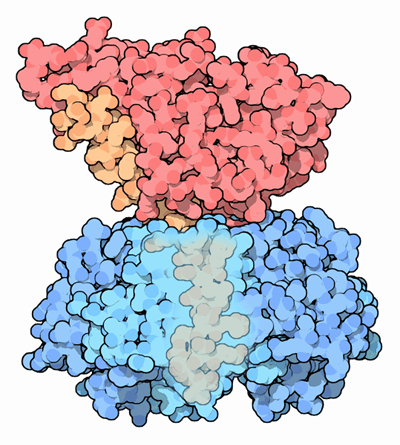Cholera pathophysiology

|
Cholera Microchapters |
|
Diagnosis |
|---|
|
Treatment |
|
Case Studies |
|
Cholera pathophysiology On the Web |
|
American Roentgen Ray Society Images of Cholera pathophysiology |
|
Risk calculators and risk factors for Cholera pathophysiology |
Editor-In-Chief: C. Michael Gibson, M.S., M.D. [1]; Associate Editors-In-Chief: Priyamvada Singh, MBBS [2]
Overview
Most of the V. cholerae bacteria do not survive the very acidic conditions of the human stomach[1]. The few bacteria that manage to survive the stomach's acidity conserve their energy and stored nutrients during passage through the stomach by shutting down much protein production and restart production in the favorable small intestine's environment. The toxins that interact with host cell mechanisms pump chloride ions into the small intestine, creating an ionic pressure which prevents sodium ions from entering the cell. The chloride and sodium ions create a salt water environment in the small intestines which through osmosis can pull up to six liters of water per day through the intestinal cells creating the massive amounts of diarrhea. The host can become rapidly dehydrated if an appropriate mixture of dilute salt water and sugar is not taken to replace the blood's water and salts lost in the diarrhea.
Pathophysiology
Cholera is mainly caused by two pathogenic serotypes O1 and O139. The pathogenesis underlying acute diarrheal illness is described as follows:[2][1]
Transmission
- V. choleraeis usually transmitted via the oro-fecal route to the human host.
- Following ingestion, the V. cholerae must overcomes the host defense mechanisms such as gastric acidity, intestinal inhibitory factors, temperature and osmolarity.
- Infective dose varies from 102-106.
Colonisation
- After gaining access to small intestine, it uses flagella to propogate through the mucus layer covering small intestine and colonises the small intestinal cells using toxin-coregulated pilus (TCP) forming a biofilm.
=Enterotoxin
- The production of enterotoxin protein in the small intestinal cells is the main mechanism responsible for causing acute diarrheal illness.
- It has 5B subunits and 2A subunits.
- B subunit binds the enterocytes via GM1 ganglioside receptors and cause interanlisation of A subunit in the cells via endocytosis.
- A subunit than binds and activates adenylate cyclase enzyme in the enterocytes increasing the level of cAMP.
- Increased levels of enterotoxin causes activation of the cystic fibrosis transmembrane conductance regulator (CFTR),r causing increased secretion of water, sodium and chloride from enterocytes causing watery diarrhea.
Virulence factors
The different virulence factors involved in the pathogenesis of V. cholerae involve activation of transcriptional factors such as ToxR, TcpP and ToxT. Different toxins expressed by these transcriptional factors include:
- Zona occludens toxin (zot, causes invasion by decreasing intestinal tissue resistance)
- Accessory cholera toxin (ace, increases fluid secretion)
- Toxin-coregulated pilus (tcpA, essential colonisation factor and receptor for the CTXf phage)
- NAG-specific heat-labile toxin (st)
- Outer membrane porin proteins (ompU and ompT).
Transmission
- Cholera is transmitted from person to person through ingestion of feces contaminated water loaded with the cholera bacterium.
- The source of the contamination is typically other cholera patients when their untreated diarrhea discharge is allowed to get into waterways or into groundwater or drinking water supply.
- Any infected water and any foods washed in the water, and shellfish living in the affected waterway can cause an infection.
- Cholera is rarely spread directly from person to person.
- V. cholerae occurs naturally in the plankton of fresh, brackish, and salt water, attached primarily to copepods in the zooplankton. Both toxic and non-toxic strains exist. Non-toxic strains can acquire toxicity through a lysogenic bacteriophage.[3] Coastal cholera outbreaks typically follow zooplankton blooms. This makes cholera a zoonosis.
References
- ↑ 1.0 1.1 Hartwell LH, Hood L, Goldberg ML, Reynolds AE, Silver LM, and Veres RC (2004). Genetics: From Genes to Genomes. Mc-Graw Hill, Boston: p. 551-552, 572-574 (using the turning off and turning on of gene expression to make toxin proteins in cholera bacteria as a "comprehensive example" of what is known about the mechanisms by which bacteria change the mix of proteins they manufacture to respond to the changing opportunities for surviving and thriving in different chemical environments).
- ↑ DiRita V, Parsot C, Jander G, Mekalanos J (1991). "Regulatory cascade controls virulence in Vibrio cholerae". Proc Natl Acad Sci U S A. 88 (12): 5403–7. PMID 2052618.
- ↑ Archivist (1997). "Cholera phage discovery". Arch Dis Child. 76: 274.